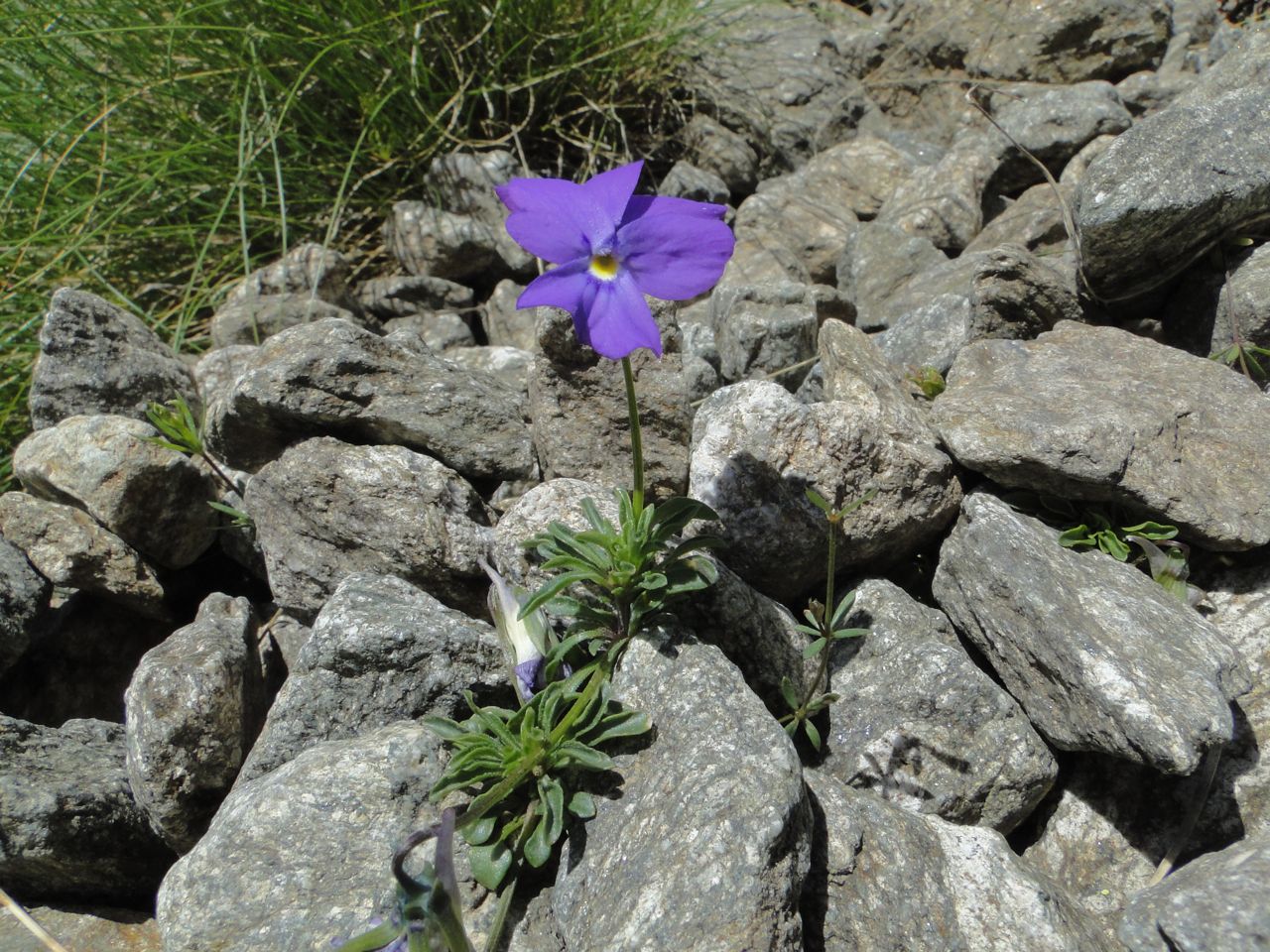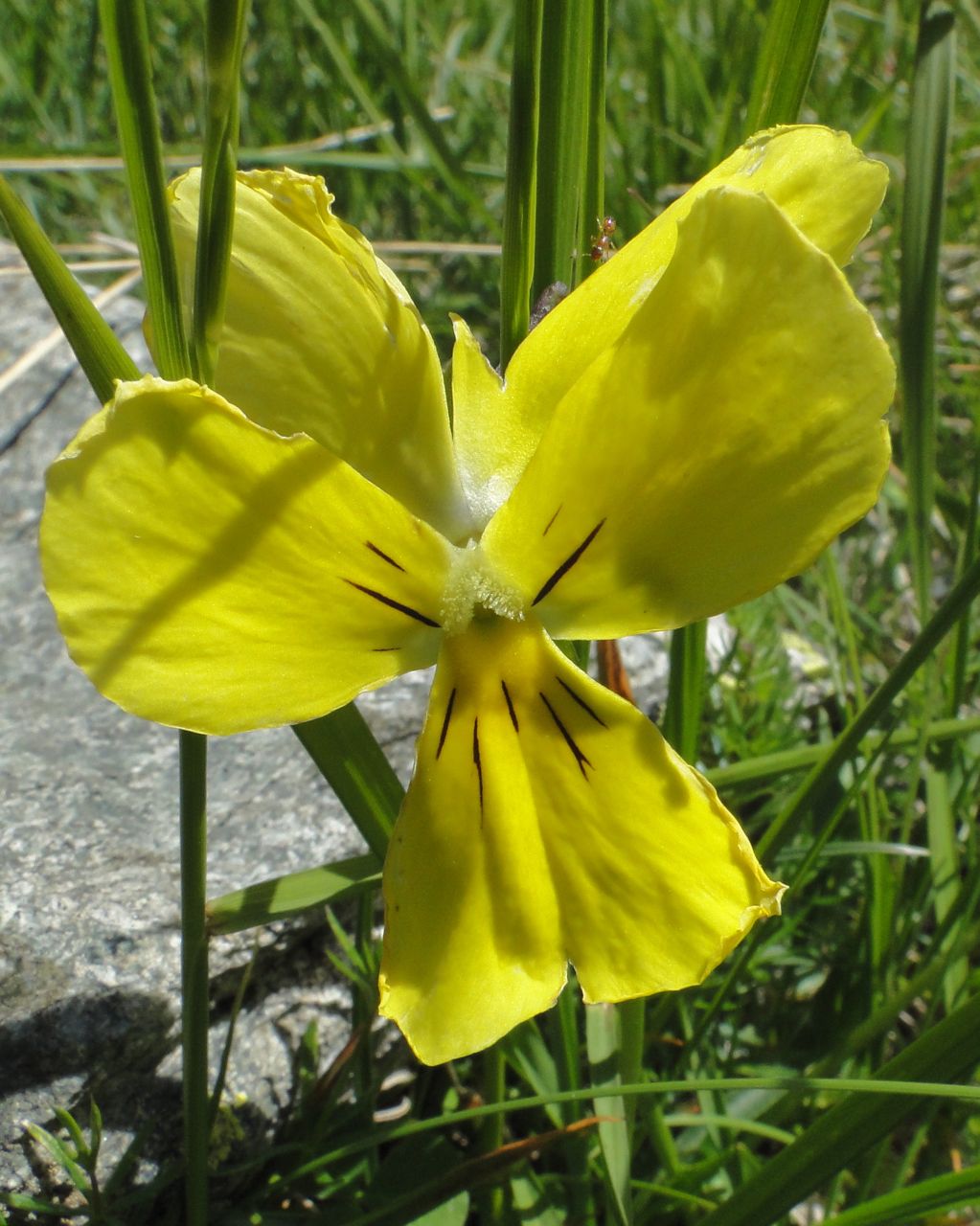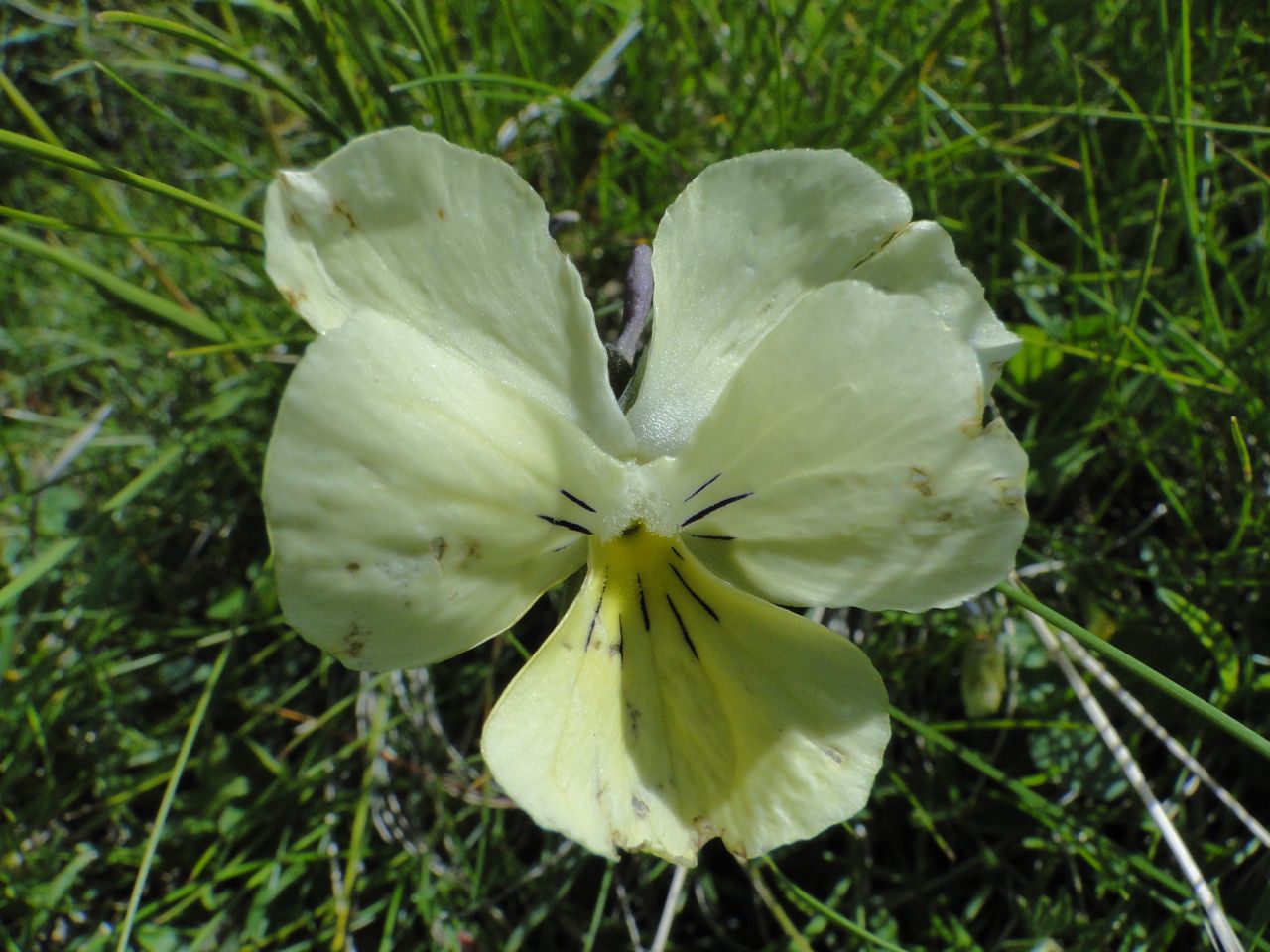Forums:
We are staying at St Dalmas about 8 km west of St Martin Vesubie. On our first day we hiked up Tete du Barn (2529 m) above Col du Barn. The access was excellent as we could drive to 2000 m on a paved road above St Dalmas.
There was lots to see a few hundred metres from the parking lot, particularly orchids. But the outstanding plant was a Maritimes Alps endemic Viola valderia growing from a tight mat of narrow leaves, unlike typical violas. The Viola lutea had huge yellow flowers some nearly white.





Comments
Sellars (not verified)
Re: Maritime Alps
Tue, 06/21/2011 - 1:20pmThere were huge fields of an old friend Ranunculus pyrenaeus on the climb up to the col and the occasional plant of Primula latifolia. A species we found that we had not seen before in the Alps was Saxifraga retusa which is similar to Saxifraga oppositifolia except it is very compact. Some of the buns were rock hard particularly the one on the cliff face with the flowers just starting to open. The Saxifraga retusa on the summit were in full flower. The flowers are very interesting hence the close-ups below.
Cliff Booker
Re: Maritime Alps
Tue, 06/21/2011 - 2:06pmWonderful pictures David ... many thanks for posting.
Lori S. (not verified)
Re: Maritime Alps
Tue, 06/21/2011 - 7:18pmWow, stunning scenes and flowers, David! Thank you for posting!
Gee, European orchids by-and-large seem to put ours to shame... we have so many non-showy ones, while there seem to be so many spectacular ones there. The ranunculus, especially, are just breath-taking. :o
Richard T. Rodich
Re: Maritime Alps
Tue, 06/21/2011 - 8:12pmi am equally impressed!
Trond Hoy
Re: Maritime Alps
Wed, 06/22/2011 - 12:36amNeedless to say, I second the opinion expressed here :D
However, I am sorry to say that these beautiful European plants don't reach Norway so I too have to go abroad to view such sights.
Sellars (not verified)
Re: Maritime Alps
Wed, 06/22/2011 - 12:32pmOn the second day we completed a classic hike in the area starting from Madone de Fenestre at about 2000 m to Col Fenestre at 2474 m. We were hoping to find Saxifraga florulenta on the cliffs above Lac Fenestre but no luck. We did see some very lovely Saxifraga pedemontana and Primula marginata on the cliffs at the pass. The photos below show some of the plants we saw together with the spectacular scenery.
(Edited to add names of species photographed, to allow for search capability. :)
Rhododendron ferrugineum, Gagea fistulosa, Gentiana acaulis )
cohan (not verified)
Re: Maritime Alps
Sun, 06/26/2011 - 1:02pmGreat stuff, David! I love the Violas besides obviously the orchids--sharing Lori's sense that many of ours are just not so exciting! We have tons of Platanthera which are mostly off green, and next most common would be yellowish Corallorrhiza!
That little Sax retusa is great, too--colour and up close texture...
Sellars (not verified)
Re: Maritime Alps
Mon, 06/27/2011 - 12:30pmIn the next few days we concentrated on seeking out some of the endemic saxes of the Maritime Alps. We found Saxifraga florulenta, Farrer's Ancient King in the Gordolasque Valley and Saxifraga cochlearis near the village of La Brigue. High up on the Col de Tende is the site of Saxifraga callosa 'Bellardii'.
Later we found S. florulenta in the Valmasque and I stuck a Euro coin above it for a scale so the size of the rosette can be appreciated.
Lori S. (not verified)
Re: Maritime Alps
Wed, 06/29/2011 - 9:17pmGorgeous rosettes there! It's wonderful how those plants all seem to be defying gravity. How did you manage those photos? Was it a cliff face next to the trail or did you have to perform some acrobatics to capture them?
Trond Hoy
Re: Maritime Alps
Thu, 06/30/2011 - 2:02amEia var jeg der! ;D
What a place to botanize! (I mean studying not picking ;))
Sellars (not verified)
Re: Maritime Alps
Thu, 06/30/2011 - 9:21amLori:
The "Ancient King" as Farrer called Saxifraga florulenta likes to occupy sheer cliff faces where no other plants will grow. It is a very "look at me plant". Nevertheless we were fortunate that some seedlings had lodged closer to ground level. Some of the photos were taken with a telephoto zoom but most were a few feet up the cliff (as with the Euro) or even below eye level right by the path. Here is a nice specimen that was easy to photograph. Although Farrer likened the rosettes to "spiny sea urchins" the leaves are remarkably soft.
Sellars (not verified)
Re: Maritime Alps
Sat, 12/03/2011 - 5:20pmI made a short video of Saxifraga callosa subsp. callosa var callosa at Col de Tende to convey the beauty of the flowers, foliage and habitat.
It can be seen at:
http://www.mountainflora.ca/Site/Mountainflora_Videos.html
Click anywhere on the picture except the arrow!!
Mark McDonough
Re: Maritime Alps
Sat, 12/03/2011 - 5:32pmBeautiful, thanks for making that and posting here; and as before, your music selection is perfect accompaniment to the scenery.
Richard T. Rodich
Re: Maritime Alps
Sat, 12/03/2011 - 8:12pmThanks so much, David.
It kinda takes my whole being away to another world. Wonderful!
Lori S. (not verified)
Re: Maritime Alps
Sun, 12/04/2011 - 10:58amAbsolutely beautiful, David! I enjoyed both the videos and the musical accompaniment very much.
Sellars (not verified)
Re: Maritime Alps
Wed, 12/28/2011 - 9:54amI made use of all the rainy days over Christmas to work on a video of Saxifraga florulenta. This is one you definitely can't grow as it has never been successfully flowered in cultivation and, because it is endangered, it is illegal to collect seed. And for all you rock lovers out there, enjoy all the rocks !
Lockwood (not verified)
Re: Maritime Alps
Wed, 12/28/2011 - 11:48amI too am enjoying the travel from my comfortable computer chair. Thank you very much David for sharing - the scenery is incredible.
Julie
Anonymous (not verified)
Re: Maritime Alps
Wed, 12/28/2011 - 5:58pmDavid,
Thank you for posting such a beautiful video. Could you share the reason this wonderful Saxifrage is endangered? I can't imagine the habitat destruction is a concern.
James
Sellars (not verified)
Re: Maritime Alps
Wed, 12/28/2011 - 8:03pmThat's a very perceptive question James. The habitat is pretty well indestructible (except with explosives), and it grows within national parks, either side of the divide between France and Italy. It was Farrer who called it the Ancient King and his account (in his book "Among the Hills") of coming across the plant is an entertaining read.
McGregor in " Saxifrages" (2008) notes that the evolution of Saxifraga florulenta occurred prior to the Pleistocene glaciations and it is likely that it has a narrow genetic constitution due to repeated near-extinctions. It has a very restricted range over a distance of about 50 km, growing only on north or north west facing granite cliffs in tight crevices. Furthermore it is monocarpic and flowers only after about 12 years or possibly even 50. Bland in "Silver Saxifrages" (2000) noted its position is precarious and that there is some evidence to suggest it may be declining from natural causes.
However in places where we found the plant it seemed to be quite vigorous and relatively common. I looked it up on the IUCN Red List of Threatened Species and it turns out that it is in the lowest category "Least Concern" and its population trend is increasing! It certainly doesn't have much competition where it chooses to grow, as shown on this photo of a blank granite wall about 100 m high with Saxifraga florulenta dotted about.
Thanks for your kind comments on the video and your question. Now that I have looked it up in the IUCN list I feel much better about the long-term survival of such a unique and spectacular Saxifrage.
Cliff Booker
Re: Maritime Alps
Thu, 12/29/2011 - 4:45amCongratulations David ... another excellent video.
Tim Ingram and I have both expressed an interest in the possibility of producing high-quality 'Society' videos that would have the potential to be used as entertaining and educational television programmes - with the intention of spreading the word about a veritable host of alpine rich habitats and our wonderful hobby. Your superb productions show that this wouldn't be such a distant dream and would prove a worthwhile venture for the alpine societies (in conjunction or individually) to pursue.
deesen (not verified)
Re: Maritime Alps
Fri, 12/30/2011 - 7:44amI really don't have the words so BRILLIANT will have to do.
Sellars (not verified)
Re: Maritime Alps
Fri, 12/30/2011 - 4:24pmCliff:
Most TV nature programs are heavy on the fauna and if you see any flora, it is only when the animal is passing by.
So much of our appreciation of alpine plants is the setting and I think it is much easier to convey the magic of wild habitat with video compared with still images. Your venture sounds worthwhile and I would be willing to help out.
Tony Willis (not verified)
Re: Maritime Alps
Sat, 12/31/2011 - 3:30pmWhat a wonderful video,we shall definitely make a trip there.
We were able to take one of David's walks to see Lewisa cotyledon in Oregon this year and nothing could have been more help to us.
gerrit (not verified)
Re: Maritime Alps
Tue, 01/03/2012 - 1:20amDavid,
I posted your video of Saxifraga florulenta on the Flemish-Dutch forum.
I think, alpine-lovers in Belgium and Holland must see this!
Tim Ingram (not verified)
Re: Maritime Alps
Tue, 01/03/2012 - 8:39amThere have been mutterings for quite a few years from knowledgeable gardeners in the UK (and I am sure elsewhere too) about the dearth of any really searching programmes on TV, both on plants in Nature and on more skilled gardening. Like Cliff says, the Alpine Garden Societies have so much expertise between them, and even more important enthusiasm, that it would really be a good time to approach TV production companies and Natural History film-makers with possible projects on these plants. As David says the amazing landscapes in which these plants grow are the key, and the drama of climate and geology. Hopefully the more of us who think about this the greater the chance of getting something off the ground!